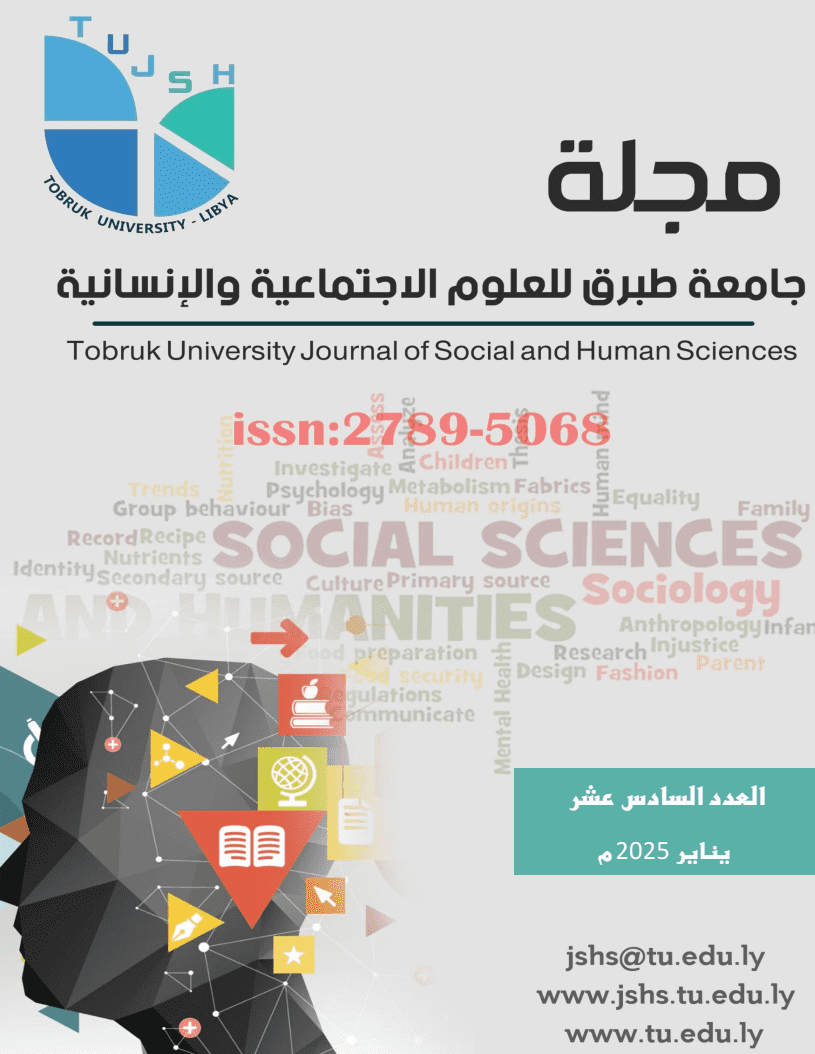Civilizational aspects of the Garamantes
DOI:
https://doi.org/10.64516/hjyqhn52Keywords:
Gramint, civilization, architecture, Fezzan, artsAbstract
The civilization of the Garamantes, which flourished in the region of Fzanya during ancient times, exhibits a range of distinctive cultural features. One of the most notable aspects is architectural art, where housing evolved from primitive forms to well-constructed buildings with defensive fortifications. Additionally, Garamante tombs reflect their connection to the afterlife, as they were built in distinctive styles and contained ornamental items that highlight local culture.
Furthermore, visual arts played a significant role in Garamante civilization, with initial drawings and engravings consisting of simple geometric shapes that later developed to display complex human and animal features. These arts were influenced by neighboring cultures, indicating the Garamantes' interaction with other civilizations.
Research Methodology
This research will adopt a historical and descriptive methodology, relying on archaeological sources and historical texts to analyze the cultural aspects of the Garamantes. This approach will facilitate a comprehensive understanding of the evolution of their civilization..
Research Questions
- What are the main aspects of Garamante civilization in the fields of architecture and arts?
- How did trade relations with other civilizations influence the development of Garamante culture?
- What role did religious beliefs play in shaping this civilization?
- How can the impact of Garamante civilization on the history of North Africa be evaluated?
Research Objectives
This research aims to:
- Explore the various cultural aspects of the Garamantes.
- Analyze the evolution of architecture and arts within a historical and social context.
- Understand the Garamantes' influence on neighboring civilizations and their interactions with them.
Importance of the Research
The significance of this research is evident in several aspects:
- Expanding Knowledge: It contributes to a deeper understanding of Garamante civilization and its historical significance.
- Enriching Academic Studies: It provides valuable information for researchers and students in the fields of history and anthropology.
Enhancing Cultural Awareness: It helps promote awareness of the importance of cultural heritage in North Africa and its role in shaping the current identity of the region
Downloads
References
- Abdusalam, Mahir Shaab Ama “The Garamantes Traders of The Desert”, Route Educational & Social Science journal, V 7.m 2020 DOI: https://doi.org/10.17121/ressjournal.2574
- C. N. Duckworth and D. J. Mattingly 'The biography of Roman vessel glass in the Sahara Desert Things that Travelled, (ed) Daniela Rosenow and others, UCL Press.2018.
- C. N. Duckworth and D. JMattingly 'The biography of Roman vessel glass in the Sahara Desert'.
- C. N. Duckworth and D. J. Mattingly 'The biography of Roman vessel glass in the Sahara Desert'.
- C.C. Law The Garamantes and the trans-saharan enterprise in classical times.
- D. Mattingly and others, Desert Migrations: people, environment and culture in the Libyan Sahara, Libyan Studies 38, 2007. DOI: https://doi.org/10.1017/S0263718900004283
- D. Mattingly and others, The Archaeology of Fazzan, Vol 1, Libyan studies and Department of Antiquities Tripoli, London, 2003.
- D. Mattting' The Garamantes of Fazzan An Early Libyan State with Trans Saharan Connections" Money'. Trade and Trade Routes in Pre-Islamic North Africa, Eds, A. Dowler and E. Galvin, London, For more information see D. Mattingly and others, The Archaeology of Fazzan, Vol 1, 2011.
- Herodotus 2.32-33, 4174.181-183, Tactius, Ann 3.74, 4.23-26, Tactius Hist 4.50, Lucan Pharaslia 4.679, 4.677-83, and Silius Italicus Punica.
- John T. Swanson, The myth of Trans-Saharan Trade During the Roman Era.
- Lucia Mori, Between the Sahara and the Mediterranean Coast: the Archaeological Research in
- M. G.Rodriguez, death is another country: Mortuary rituals and identity in Fazzan, Libya, MA Thesis, university of Leicester, 2014.
- M. Liverani, ,The Libyan Caravan Road in Herodotus IV.
- O. Bates , The Eastern libyans an Essay, Macmillan And co., limited, London.
- R. Joorde , Roman forays into the interior of sub-Saharan Africa,
- R.c.c. Law, the garamamtes and trans-saharan enterprise in classical times.
- R.E.Pelling, Agricglture and trade amongst the garamantes and the fezzanese: 3000 years of archaeobotanical from the sahara and its margins, ProQuest, 2013.
- R.E.Pelling, Agricglture and trade amongst the garamantes and the fezzanese and Lucia Mori, Between the Sahara and the Mediterranean Coast.
- Raffael Joorde, Roman forays into the interior of sub-Saharan Africa: the mysterious landscape of Agisymba, 2015.
- Sonja Magnavita, Initial Encounters: Seeking traces of ancient trade connections between West Africa and the wider world, Afriques (04), 2013. DOI: https://doi.org/10.4000/afriques.1145
- C. N. Duckworth and D. J. Mattingly, 'The biography of Roman vessel glass in the Sahara Desert',.
- Nick Brooks, REVIEW, Aghram Nadharif: The Barkat Oasis (Sha'Abiya of Ghat, Libyan Sahara) in Garamantian Times Published in Antiquity, Vol. 81 Issue 314, 2007.
- John Speed, Title: A New Map of the Roman Empire, from "A Prospect of the Most Famous Parts of the World", pub. Basse, Location: London, O'Shea Gallery, Picture mumber: BAL42841.
- Lucia Mori, Between the Sahara and the Mediterranean Coast: the Archaeological Research in the Oasis of Fewet (Fazzan, Libyan Sahara) and the Rediscovery of the Garamantes, Roma, 2010.
- Marina Gallinaro, Saharan Rock Art: Local Dynamics and Wider Perspectives, Art, 2013 DOI: https://doi.org/10.3390/arts2040350
Downloads
Published
Issue
Section
License
Copyright (c) 2025 الدكتور خالد آدم أحميدة (Autor/in)

This work is licensed under a Creative Commons Attribution 4.0 International License.








